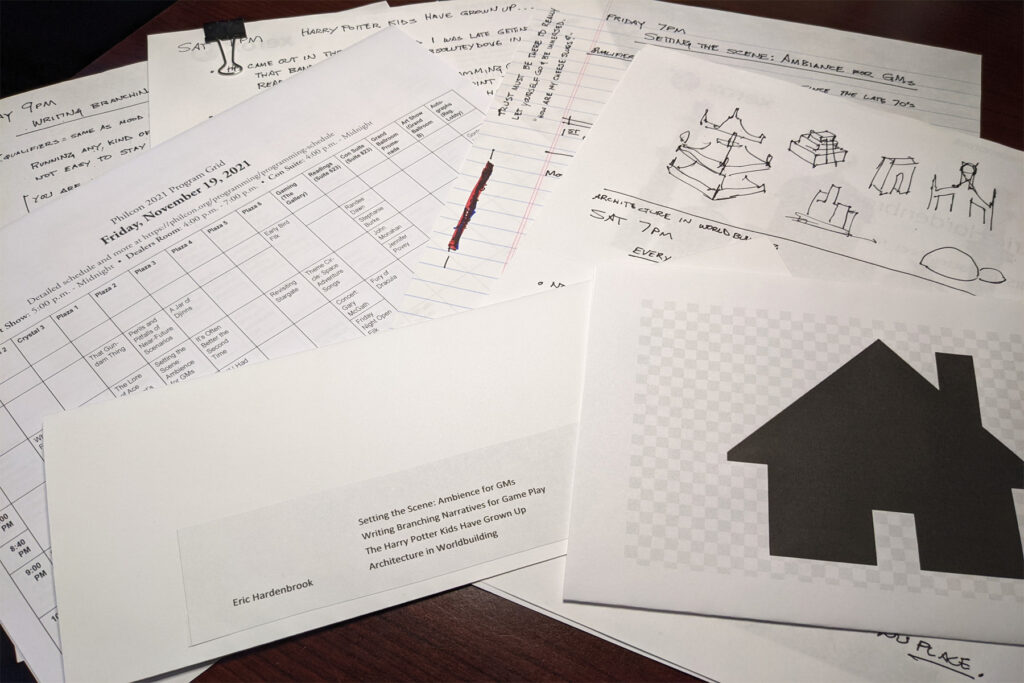My Saturday panels at Philcon were up and down in my mind and I headed into the first one with some trepidation. The last one I headed into with confidence.
First up was The Harry Potter Kids Have Grown Up
There was some email communication about this panel before we got to the con. There were a lot of very qualified folks set up to speak on the topic. An elementary school librarian, an author of HP related articles, leader of fan clubs and quite a few other bits and pieces. My particular qualifications were simply the work that I had done as the head of children’s programs as con staff at a number of other conventions. All the information I had to bring was basically anecdotal. One of the parts that worried me most was the expression of a particular viewpoint relating the the author of the HP series and her stance as it relates to the gay and specifically the trans community. Based on the email I was worried that this panel was going to devolve into a bash session of the author and a feel good agreement circle to be sure everyone was saying the right things in order to fit in. It weighed on me not because I want to defend the author or to cause strife with any part of any community, but because I’ve been to panels expecting one thing only to get a bash session and went away disappointed. I do not want to have folks walk away from panels I’m on disappointed.
To the moderator’s great credit, she felt the same way about panels. She made it a point to hit on all the things listed in the panel description in the program book and asked questions of the panelists to dig into each of them. It was a great relief to me. Once I knew we weren’t going off the rails, it was far easier to enjoy what everyone had to say.
As to my thought on the panel topic itself ~ it’s impossible to deny the impact that Harry Potter has had on culture. Not just publishing or film, but also crafts, conventions and even sports.
At somewhere past the 20 year mark for the Harry Potter phenomenon, the kids who were 9 or 10 when they dove into the wizarding world are now old enough to be having families of their own. There were dozens if not hundreds of kids at our conventions back in 2017 and 2018 that wanted to be a wizard and compete for the house trophy. Reading was, if not cool, accepted for the sake of consuming these stories. Comparisons between the book and the film were a staple of any chat. Kids had (and have) a thing that can be theirs. It no longer has the intensity of when the books were first coming out, but each child that gets to read them now still gets the chance to enter that world for the first time. That is an important change, and one I’m glad to see.
Tied together with that chance at new worlds is the backlash crowd. There are always those that will push back against anything popular, but adding wizards and magic spells to the mix brings a special kind of push back. I have discussed in various forms before how I lived through the Satanic Panic back when Dungeons & Dragons was being called a devil’s tool. What we didn’t have back then, at least not to any significant degree was any kind of alternate. One of the other important impacts that the HP books have had, and the kids that have grown up now give us is that alternate. They learned from the previous panics and didn’t allow social stigma to stop them. They supported each other. They had (and continue to have) a different kind of magic from the lands of the role playing game. Magic inhabits books and games and movies now in all sorts of new ways. WE all continue to benefit from this huge push by the kids of this generation.
The panel also went into how many of these so called HP kids have started to move into creative fields. They are writers, film makers, creators. Twenty more years from now it will still be something that people of that generation will be able to bond over, much the same way Gen X folks relate to Star Wars. The panel all seemed to agree there was a great degree of hope in this.
I will admit I had a couple of other things I wanted to delve deeper on, but the panelists on this one were very into the topic. I sat back and let folks with much deeper connections really take the lead. It was busy, informative and made the 50 minutes of the panel just flash past. The topic of the author’s current stance on certain issues did come up, but it was truly handled really well. It’s a simple claim, and one that makes sense. IF you feel you need to remove anything HP from your life based on what the creator has said recently, it is entirely up to you and no one can or should judge you for that. IF you want to ignore the creator, that is entirely fair as well. At a certain point the creation no longer belongs to the creator ~ so if these stories meant something deep to you, keep that and enjoy what you have. Nobody should be able to take away meaningful experiences from you.
It was a good thing I had some time between all that and the Architecture in World Building panel.
My day job is as a project designer for a major architecture and engineering firm. Architecture is my profession, so talking about it would be easy… right?
As it turns out I got to share this panel with the guest of honor for the convention. She was a delight to chat with and I’m really glad I could bring a few insights to the panel. The moderator was going at around a hundred miles per hour, but I made an effort to keep all the folks involved on the panel. I don’t know if I succeeded, but I was just as interested in hearing what the other panelists had to say as anything else.
There were some cool questions from the audience too. We all tried to put books and learning path type things out there for the folks asking the questions. I recommended a couple of titles I was familiar with and put a few points forward that seemed to be well taken. Here are a few of those:
Everyone interacts with the built environment in some way. Even if you never step inside a designed structure, that is likely a conscious choice.
No matter what level of training you have (or don’t) you will likely have an opinion on some aspect of the built environment. IF you’re going to hold an opinion, have something to back it up with. Yes, aesthetics is something you can back it up with but the views on that vary as widely as people’s favorite color.
Buildings go DEEP into societies. Deep to the point where I can show you the combination of a rectangle and a triangle and you’ll recognize what I mean. IF you’re considering the architecture in the world building for you story don’t forget to consider what impact it has on the kids.
Is what you’re creating believable? Not everyone will have a background in how a building (or a city) will actually function. Can you make what you’re showing believable to the second step? This is something another author passed to me once. IF you only push your creative thought to the first thing somebody can look up, they may question your world. IF you can get past that to the second step… that is you’ve thought logically to the part a reasonable person might have a question about, that will make most people think, “Huh.” and then keep reading. Give enough thought that what you’re creating doesn’t push past a readers willing suspension of disbelief.
Lastly, architecture gives your world depth. It gives detail. It gives a sense of place. That will show through to your readers even if you never get to give out all the pages and pages of research you did to come up with all that. It’s vital to consider the place where your characters are in more than just a “oh, that’s the background…” kind of way.
And those were the panels for my Philcon this year. I was really happy with how they all went. I could have, and frankly wanted to, keep talking on the subjects for hours more. I think that’s a sign of a good convention. I can’t wait to do it again.



